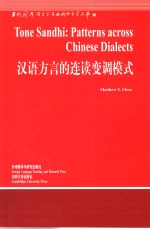

汉语方言的连续变调模式 英文版PDF电子书下载
- 电子书积分:17 积分如何计算积分?
- 作 者:Matthew Y.Chen著;王嘉龄导读
- 出 版 社:北京:外语教学与研究出版社
- 出版年份:2001
- ISBN:7560023878
- 页数:563 页
1 Setting the stage 1
1 Languages and dialects of China 1
2 Historical background 4
Preface by Halliday 10
王宗炎序 11
3 Tone patterns in present day dialects 13
Preface by Chomsky 14
4 Tones in context 19
沈家煊序 21
导读 24
Preface 37
5 Synchronic relevance of diachrony 38
Notational conventions 43
6 Citation tone,base tone,sandhi tone 49
2 Tonal representation and tonal processes 53
1 Tonal representation 53
2 The autosegmental status of tone 57
3 Tonal geometry and the typology of spread/shift rules 63
4 Dissimilation and substitution 79
5 Neutralization and differentiation 84
Appendix Tone features 96
1 The nature of the problem 98
3 Directionality and interacting sandhi processes I 98
2 Tianjin:directionality effect 105
3 A derivational account 110
4 Constraints on derivation? 118
5 A non-derivational alternative 122
6 Cross-level constraints 134
7 Harmonic serialism 140
8 Concluding remarks 147
4 Directionality and interacting sandhi processes II 150
1 Changting:preamble 150
2 Temporal Sequence and No-Backtracking 153
3 Temporal sequencing vs.structural affinity 158
4 Derivational economy and structural complexity 165
5 Concluding remarks 172
5 From base tones to sandhi forms:a constraint-based analysis 174
1 Background 176
2 Parallel constraint satisfaction 179
3 Constraint ranking 186
4 Opacity 201
5 Competing strategies 209
Appendix Sandhi forms of disyllabic compounds(New Chongming dialect) 218
6 From tone to accent 219
1 Shanghai:an aborted accentual system? 220
2 New Chongming:an emergent accentual system 225
3 Culminative accent 232
4 Saliency and Edgemostness 244
5 Prosodic weight and recursive constraint satisfaction 253
6 Tonic clash 267
7 Semantically determined prominence 277
8 Leveling 280
7 Stress-foot as sandhi domain I 285
1 The phonological status of stress in chinese 286
2 Stress-sensitive tonal phenomena 295
3 Shanghai:stress-foot as sandhi domain 306
8 Stress-foot as sandhi domain II 320
1 Wuxi:stress shift 320
2 Danyang:asymmetric stressclash 325
3 Nantong:stress-foot and p-word 341
9 Minimal rhythmic unit as obligatory sandhi domain 364
1 Minimal rhythmic units 366
2 A two-pass MRU formation 380
3 The syntactic word 386
4 The phonological word 396
5 Summary 403
6 The prosodic hierarchy 404
7 Syntactic juncture 414
8 Meaning-based prosodic structure 417
Appendix Prosodic and syntactic word 426
10 Phonological phrase as a sandhi domain 431
1 End-based p-phrase 431
2 Supporting evidence for p-phrase 441
3 M-command or domain c-command 446
4 Lexical government 455
5 Rhythmic effect in Xiamen 471
11 From tone to intonation 475
1 Wenzhou tone system 476
2 Word-level tone sandhi 477
3 Clitic groups 486
4 Phrasal tone sandhi 490
5 Intonation phrasing 494
6 Tonic prominence 499
Concluding remarks 504
Bibliographical appendix Tone sandhi across Chinese dialects 507
References 523
Subject index 545
Author index 551
文库索引 555
- 《卓有成效的管理者 中英文双语版》(美)彼得·德鲁克许是祥译;那国毅审校 2019
- 《AutoCAD 2018自学视频教程 标准版 中文版》CAD/CAM/CAE技术联盟 2019
- 《跟孩子一起看图学英文》张紫颖著 2019
- 《AutoCAD机械设计实例精解 2019中文版》北京兆迪科技有限公司编著 2019
- 《知识管理背景下的档案管理模式》曾祯,金瑞,王聪颖著 2019
- 《复分析 英文版》(中国)李娜,马立新 2019
- 《海河干流水环境质量与经济发展模式研究》于航白景峰,张春意 2019
- 《二十四史导读 第1册 (附《清史稿》导读)》孟繁华,许嘉利主编 2013
- 《张世祥小提琴启蒙教程 中英文双语版》张世祥编著 2017
- 《互联网+时代的日语教学模式探究》郭晓雪著 2019
- 《中风偏瘫 脑萎缩 痴呆 最新治疗原则与方法》孙作东著 2004
- 《水面舰艇编队作战运筹分析》谭安胜著 2009
- 《王蒙文集 新版 35 评点《红楼梦》 上》王蒙著 2020
- 《TED说话的力量 世界优秀演讲者的口才秘诀》(坦桑)阿卡什·P.卡里亚著 2019
- 《燕堂夜话》蒋忠和著 2019
- 《经久》静水边著 2019
- 《魔法销售台词》(美)埃尔默·惠勒著 2019
- 《微表情密码》(波)卡西亚·韦佐夫斯基,(波)帕特里克·韦佐夫斯基著 2019
- 《看书琐记与作文秘诀》鲁迅著 2019
- 《酒国》莫言著 2019
